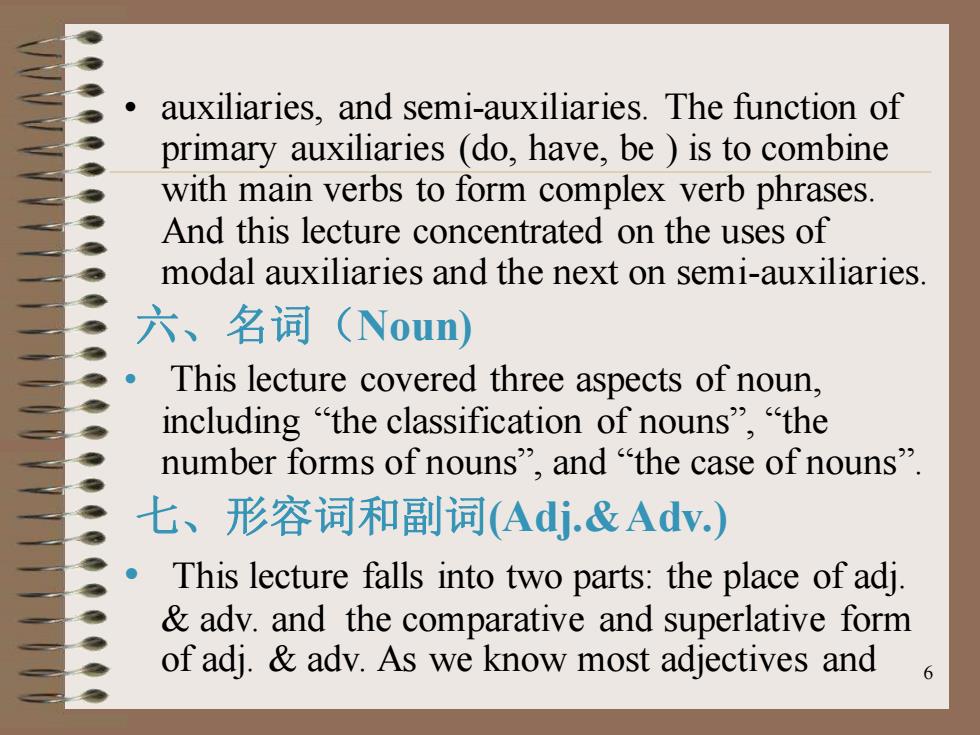
auxiliaries,and semi-auxiliaries.The function of oO primary auxiliaries (do,have,be )is to combine with main verbs to form complex verb phrases And this lecture concentrated on the uses of modal auxiliaries and the next on semi-auxiliaries. 六、名词(Noun) This lecture covered three aspects of noun, including "the classification of nouns","the number forms of nouns",and "the case of nouns". 七、形容词和副词(Adj.&Adv.) This lecture falls into two parts:the place of adj adv.and the comparative and superlative form of adj.adv.As we know most adjectives and
6 • auxiliaries, and semi-auxiliaries. The function of primary auxiliaries (do, have, be ) is to combine with main verbs to form complex verb phrases. And this lecture concentrated on the uses of modal auxiliaries and the next on semi-auxiliaries. 六、名词(Noun) • This lecture covered three aspects of noun, including “the classification of nouns”, “the number forms of nouns”, and “the case of nouns”. 七、形容词和副词(Adj.& Adv.) • This lecture falls into two parts: the place of adj. & adv. and the comparative and superlative form of adj. & adv. As we know most adjectives and
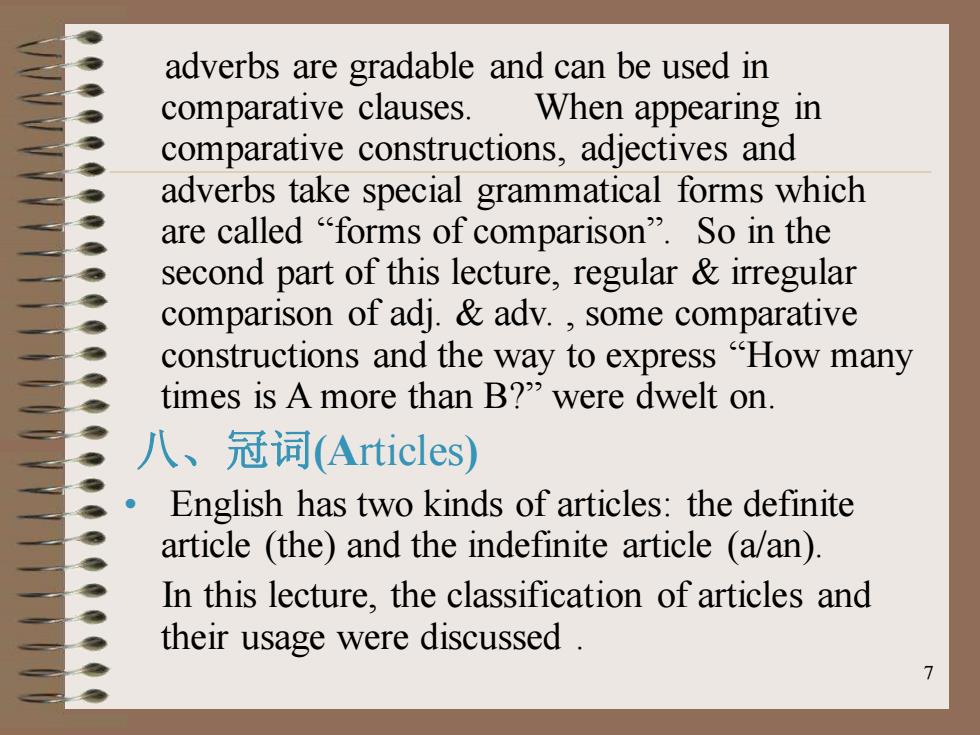
adverbs are gradable and can be used in comparative clauses. When appearing n comparative constructions,adjectives and adverbs take special grammatical forms which are called“forms of comparison”.So in the second part of this lecture,regular irregular comparison of adj.adv.some comparative constructions and the way to express "How many times is A more than B?"were dwelt on. 八、冠词(Articles) English has two kinds of articles:the definite article (the)and the indefinite article (a/an). In this lecture,the classification of articles and their usage were discussed
7 adverbs are gradable and can be used in comparative clauses. When appearing in comparative constructions, adjectives and adverbs take special grammatical forms which are called “forms of comparison”. So in the second part of this lecture, regular & irregular comparison of adj. & adv. , some comparative constructions and the way to express “How many times is A more than B?” were dwelt on. 八、冠词(Articles) • English has two kinds of articles: the definite article (the) and the indefinite article (a/an). In this lecture, the classification of articles and their usage were discussed
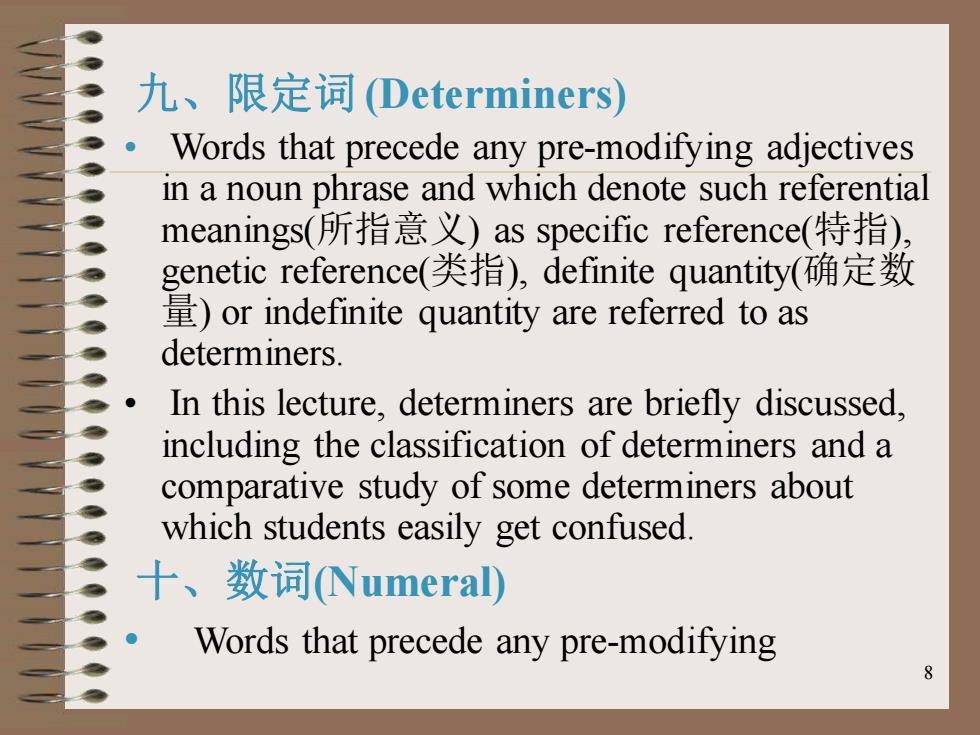
九、限定词(Determiners) Words that precede any pre-modifying adjectives in a noun phrase and which denote such referential meanings(所指意义)as specific reference(特指), genetic reference(类指),definite quantity(确定数 or indefinite quantity are referred to as determiners. In this lecture,determiners are briefly discussed, including the classification of determiners and a comparative study of some determiners about which students easily get confused 十、数词Numera) Words that precede any pre-modifying
8 九、限定词(Determiners) • Words that precede any pre-modifying adjectives in a noun phrase and which denote such referential meanings(所指意义) as specific reference(特指), genetic reference(类指), definite quantity(确定数 量) or indefinite quantity are referred to as determiners. • In this lecture, determiners are briefly discussed, including the classification of determiners and a comparative study of some determiners about which students easily get confused. 十、数词(Numeral) • Words that precede any pre-modifying
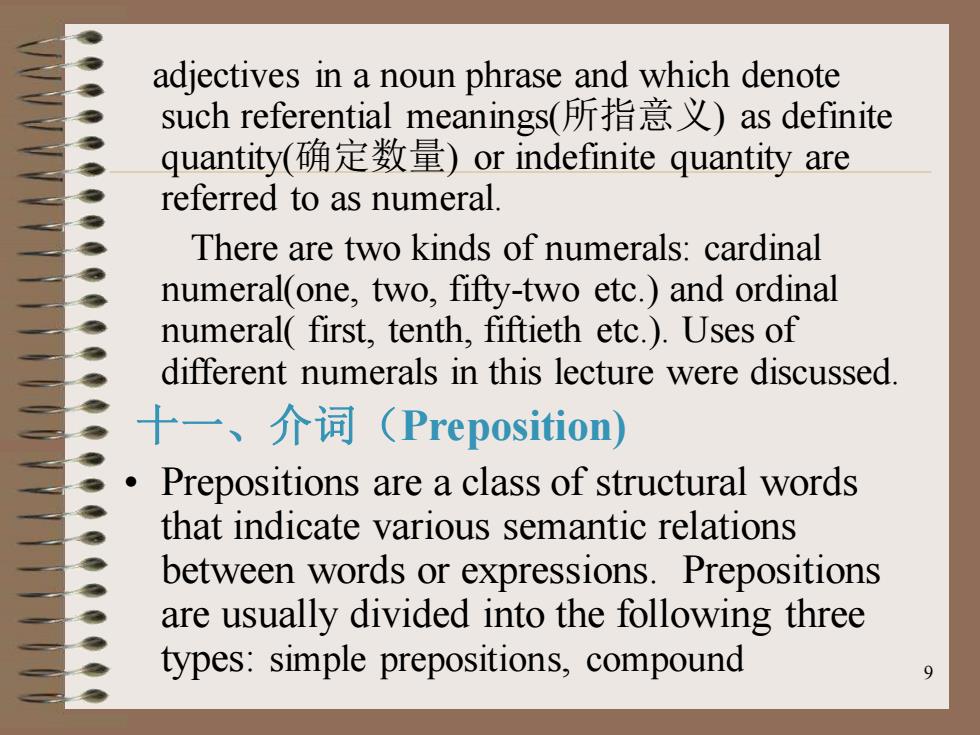
adjectives in a noun phrase and which denote such referential meanings((所指意义)as definite quantity(确定数量)or indefinite quantity are referred to as numeral. There are two kinds of numerals:cardinal numeral(one,two,fifty-two etc.)and ordinal numeral(first,tenth,fiftieth etc.).Uses of different numerals in this lecture were discussed 十一、介词(Preposition) Prepositions are a class of structural words that indicate various semantic relations between words or expressions.Prepositions are usually divided into the following three types:simple prepositions,compound
9 adjectives in a noun phrase and which denote such referential meanings(所指意义) as definite quantity(确定数量) or indefinite quantity are referred to as numeral. There are two kinds of numerals: cardinal numeral(one, two, fifty-two etc.) and ordinal numeral( first, tenth, fiftieth etc.). Uses of different numerals in this lecture were discussed. 十一、介词(Preposition) • Prepositions are a class of structural words that indicate various semantic relations between words or expressions. Prepositions are usually divided into the following three types: simple prepositions, compound
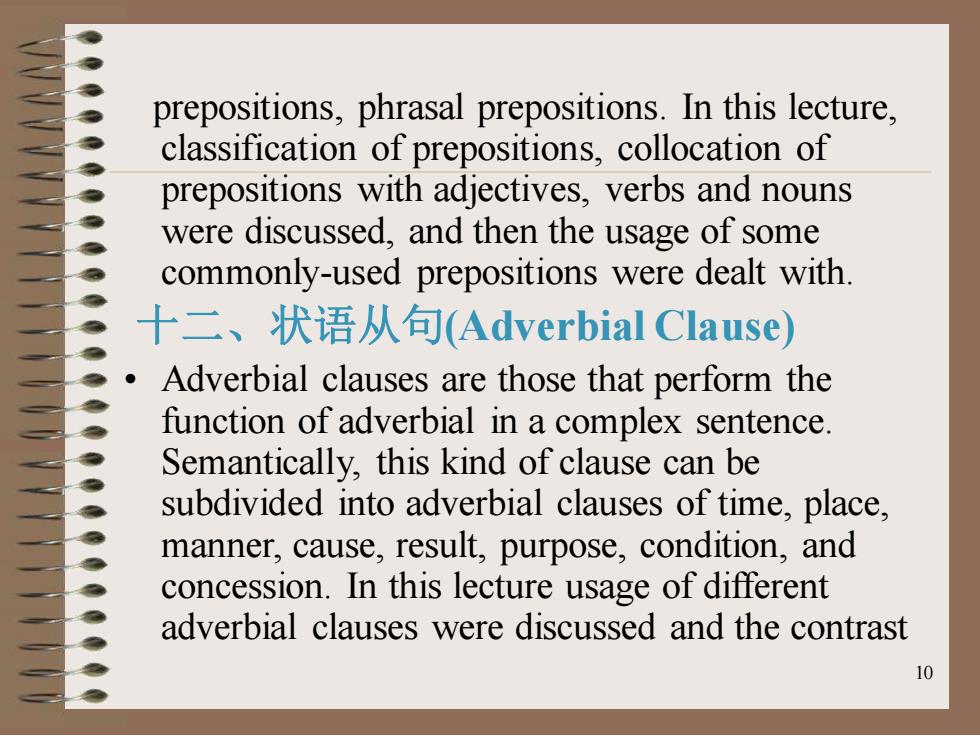
prepositions,phrasal prepositions.In this lecture, classification of prepositions,collocation of prepositions with adjectives,verbs and nouns were discussed,and then the usage of some commonly-used prepositions were dealt with. 十二、状语从句(Adverbial Clause) Adverbial clauses are those that perform the function of adverbial in a complex sentence. Semantically,this kind of clause can be subdivided into adverbial clauses of time,place, manner,cause,result,purpose,condition,and concession.In this lecture usage of different adverbial clauses were discussed and the contrast 10
10 prepositions, phrasal prepositions. In this lecture, classification of prepositions, collocation of prepositions with adjectives, verbs and nouns were discussed, and then the usage of some commonly-used prepositions were dealt with. 十二、状语从句(Adverbial Clause) • Adverbial clauses are those that perform the function of adverbial in a complex sentence. Semantically, this kind of clause can be subdivided into adverbial clauses of time, place, manner, cause, result, purpose, condition, and concession. In this lecture usage of different adverbial clauses were discussed and the contrast